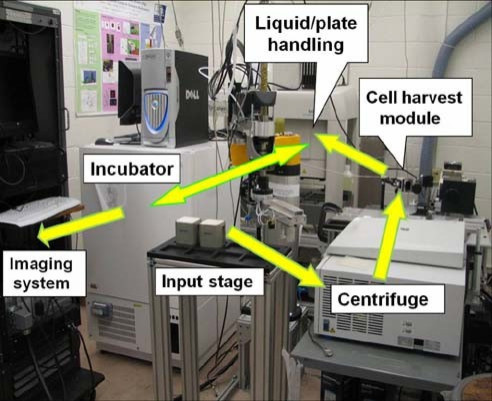A New Method For Mass Testing For Radiation Damage

The recent nuclear disaster in Japan has put a spotlight on measuring radiation dosage and the health effects, and how to diagnose thousands of people at a time.
David Brenner, a professor of radiation biophysics at Columbia University, has developed a prototype system for getting accurate dosages of radiation from dozens of people at once, and getting the results of thousands of tests in a few days (up to 30,000 per day). Called the Rapid Automated Biodosimetry Tool (RABIT) it is designed to test blood samples for radiation damage and enable health workers to quickly determine who needs immediate medical treatment and who does not.
Current methods for testing the actual dose inside the body's tissues require many hours or even days to process. That's because in order to measure the damage to cells caused by radiation one has to examine the cells themselves. Just looking at the dosage using a Geiger counter or dosimeter badge won't tell you much, Brenner says, because it just measures the contamination on the outside of the body. The real damage is caused by radioactive material that gets inside the body, such as cesium or iodine isotopes.
There are two methods of assessing damage. One is to look for an enzyme called gamma H2AX, which is a chemical produced by cells as they repair their DNA. Gamma-H2AX disappears from cells in a few days as the repairs are completed. The second is micronucleus assay, which involved looking at pairs of cells that have just divided. If there is a third, small cell next to the daughter cells, it means a small bit of material (containing DNA) from the cell nucleus has broken off. Either method takes some time, with micronuclear assays taking up to three days and gamma-H2AX detection taking hours.
Both methods are necessary, Brenner says, because one only works within a few days of exposure, while the other takes longer, but can be applied when it isn't clear when the exposure occurred. The only problem is that in a situation where lots of people need to be tested, current lab techniques are too slow (a typical lab might be able to handle 10 samples at a time). Another problem with current methods, he says, is that blood has to be drawn, usually from a vein, and that has to be done by a person with some training.
The RABIT can test up to 96 samples, all taken by simply pricking a finger. By automating the process of testing for gamma-H2AX and the micronuclear assay, the machine can get through a workload in a few hours that would tie up a lab for days.
Speed of testing is important, Brenner said, in order to decide whether people need treatment for radiation poisoning or not, and what kind. A dose below 1 sievert over a short period probably won't cause acute health problems. But there is a wide range between doses of 1 sievert, which can cause illness, and 10 sieverts, at which death is pretty certain. Within that high region you need to know the dose well, Brenner said, as the treatment for radiation poisoning is different for the various dosages. Some workers at Chernobyl, for example, got bone marrow transplants they didn't need because they were incorrectly diagnosed.
RABIT can also be used to assure people that they don't need treatment in the first place and work for the worried well -- preventing overreactions such as the run on iodine pills in California.
There is still some experimental work to be done, Brenner notes. RABIT still has to be calibrated further so it can account for differences between smokers and nonsmokers, for example, or different susceptibilities to radiation. It is also not clear whether it needs to be adjusted for various ethnic groups, or for differences between men and women.
RABIT also won't detect certain kinds of radiation damage. It is focused on contaminants that get into the bloodstream. Cesium does that, as well as strontium (via the bone marrow). Iodine isotopes have short half-lives and concentrate in the thyroid, so they might not show as clearly.
The RABIT project started six years ago, when the U.S. government started thinking about the possibility of radiological weapons in terrorist attacks. A request for proposals went out to find treatments for radiation poisoning. Brenner says most groups went for drug development, but he thought detection and diagnosis would be just as useful.
© Copyright IBTimes 2024. All rights reserved.





















